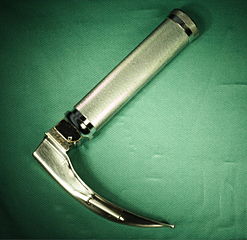The definitions below roughly follow the order of appearance in the story and are organized by chapter. Most of our medical and surgical terminology derives from Greek or Latin, so anything that is italicized originated from one of those two languages.
CHAPTER 1
Succinylcholine: (sucks-in-il-kō’-lēn) a short-acting intravenous drug that paralyzes every muscle in the body within seconds, including the breathing muscles, therefore necessitating immediate intubation. It is often used to paralyze combative or unstable patients who need to be intubated emergently.
Ventricular fibrillation: complete loss of the rhythmic contraction of the heart. The muscle fibers continue to contract, but in a disorganized and independent fashion, giving the fibrillating heart a “bag of worms” appearance. No longer receiving blood, the heart muscle quickly becomes hypoxic (hypo = under; ox- = oxygen) and turns a blackish-blue color. Without treatment, VF is fatal within minutes.
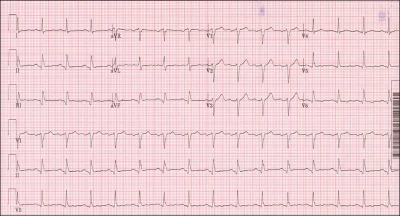
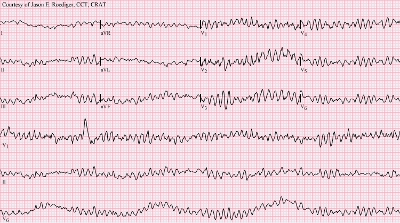
Feculent: foul with impurities, but most often associated with the properties of feces (stool, excrement). For example: a feculent odor, a feculent discharge, hair matted with feculent material, etc.
E. coli: Escherichia coli are bacteria found in the environment, foods, and intestines of people and animals. Most strains are harmless, but others can make you very sick. Common E. coli infections include diarrhea, urinary tract infections, wound infections, and pneumonia. Every once in awhile, however, we will hear about tainted meat that contains a particularly virulent strain leading to an outbreak of severe illness and even death.

CHAPTER 2
P90: a compact but powerful assault weapon originally developed for military and law enforcement applications, but now available to anyone who can pass a background check, or anyone who knows someone who knows a guy. This bad boy can hold up to fifty rounds and is available in fully automatic (LE and military) and semi-automatic (civilian) capabilities. As soon as my concealed carry permit is approved, I’ll never again leave home without mine.

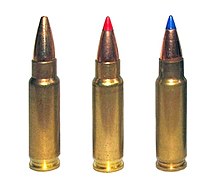
CHAPTER 15
Uremic encephalopathy: Uremia is a complication of chronic kidney disease and acute kidney injury (i.e. acute renal failure). It occurs when urea and other waste products build up in the body due to the kidney’s inability to eliminate them. Dialysis does a good job of ridding the body of these compounds, but over time, cells, tissues, and organs are damaged despite treatment. When brain function is affected, it is referred to as uremic encephalopathy.
CHAPTER 21
Kidney anatomy: Anatoly, Viktor, and Mikhail Petrovsky are all correct. A good portion of the kidney is up under the ribs, but the lower portion resides below the twelfth rib.
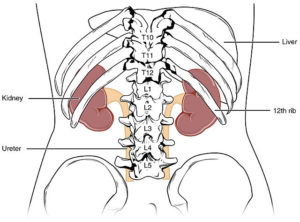
CHAPTER 22
Tension pneumothorax: Everything you need to know about this life-threating condition is in the video. I apologize for the soundtrack. I would have used “C’mon feel the noise, girls rock your boys” by Quiet Riot if I had produced it.
CHAPTER 24
Ambu or oxygen bag: a pliable plastic bag the size and shape of a football. By repeatedly squeezing the bag, oxygen is pumped into the lungs. During respiratory distress or cardiac arrest, bagging is preferred over mechanical ventilation in that a higher respiratory rate can be achieved.
Larynx: the “voice box” or “Adam’s apple.” This is where the vocal cords reside and the trachea begins.
Laryngoscope: an L-shaped instrument with a handle and a detachable blade. The blade is placed into the pharynx, and by lifting the base of the tongue, the vocal cords (which reside in the larynx) are visualized. The endotracheal tube is then advanced through the cords into the trachea.
Endotracheal tube: a plastic tube that is inserted through the mouth (or nose) and advanced into (endo = within) the trachea. It gives the first responder or ER physician control of the airway.
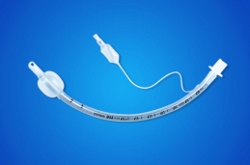
Intubate: the act of placing an endotracheal tube.
Pulmonary contusions: If you smash your thumb with a hammer, the capillaries become “leaky,” allowing serum, rich in inflammatory cells, to leave the blood stream and start the healing process. When the lungs are contused (bruised), fluid leaks from the capillaries into the air sacs where oxygen exchange takes place. When these sacs fill with fluid, oxygen cannot enter the bloodstream. If the contusions are bilateral (involving both lungs), the patient becomes progressively hypoxic and may reach a point where, despite mechanical ventilation, they cannot be oxygenated and they die.
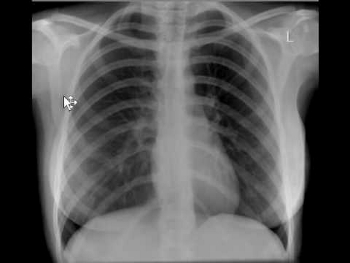
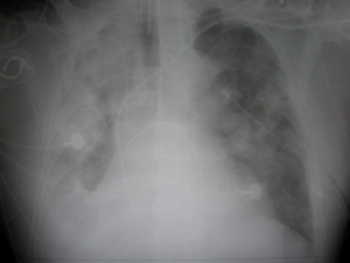
Pleurevac: a disposable collection system that drains unwanted blood (hemothorax), pleural fluid (pleural effusion), or air (pneumothorax) from the pleural space. The pleural space is the cavity within the thorax (chest) where the lungs reside.
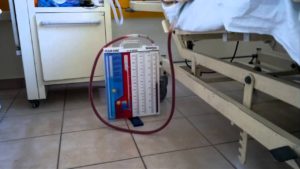
CHAPTER 27
ATP: adenosine triphosphate. This organic compound is the basic unit of energy used by every cell in the body. No ATP, no cellular function. No cellular function, no life-sustaining processes. No life-sustaining processes, death. Oxygen is necessary for the efficient production of ATP, so you can imagine David McBride’s excitement when he learns there may be a way to generate ATP in the absence of oxygen (in this case using photons of light). This is not only important for the growth of Heather Whitestone’s kidney, but it could have profound implications for science and medicine.
CHAPTER 29
Fractured fibula: This is a nondisplaced fracture, meaning the ends of the bone have moved very little. The tibia is the larger bone to the right. The ankle joint is at the bottom of the film.
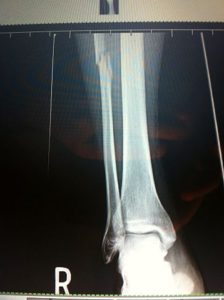
CHAPTER 39
Extracellular matrix: The use of mammalian organ scaffolds, primarily ferret and porcine (pig), is an area of great promise in the effort to grow bioengineered human organs in the laboratory. The intact animal organ is placed in a detergent bath, which washes away all the cellular components, leaving behind an extracellular matrix of non-immunogenic proteins and polysaccharides (complex, structural sugars). This decellularized matrix is then infused with progenitor cells (a close descendant of the stem cell) and endothelial cells (which form the lining of blood vessels and other tubular structures within organs). By using a scaffold that has been “cleaned” of all “donor” cellular components, and infused with the recipients own progenitor and endothelial cells, the bioengineered organ will not trigger an immune response when transplanted into the human recipient.
The Ghost Kidney: Many of the organ-growing techniques I describe in this story are based in reality, including the use of decellularized, or “ghost” organs as scaffolds for the growth of human organs. The process is described above. The end result is pictured below.
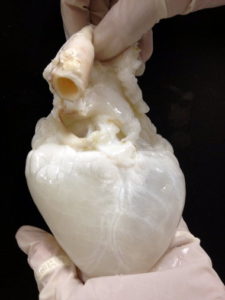
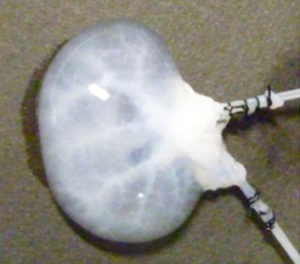
This video depicts exactly what David McBride is doing in the lab, except his glass cylinder is way cooler than these big jars:
CHAPTER 40
Anterograde: moving or flowing forward.
Retrograde: moving or flowing backward.
Renal vessels: Renalis is Latin for kidney. The renal artery carries blood to the kidney. The renal vein carries it away.
Ureter: tubular structures that carry urine from the kidney to the bladder. Each kidney has one.
Glomeruli: micro-organs within the kidney that filter waste products and excess fluid from the blood. This is the first step in the production of urine.
Cannula: a tube, usually plastic, that can be used to infuse fluids into an organ or body cavity, drain fluids from an organ or body cavity, or function as a portal through which surgical instruments can be passed. The act of placing a cannula is called cannulation. The rat kidney in the photo above has been cannulated.
CHAPTERS 41 – 81: Go here.


